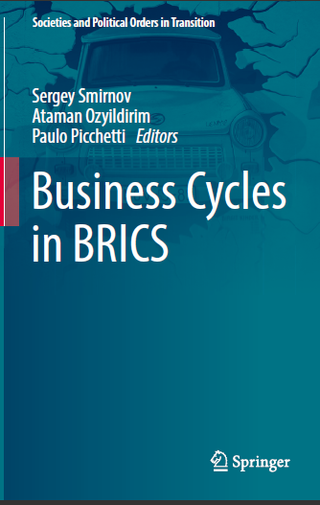?
Institutions, Productivity Change and Growth
Ch. 3. P. 29–54.
Ключевые слова: политические институтыэкономический ростeconomic growthBRICSБРИКСpolitical institutionstotal factor productivityсовокупная производительность факторов производства
ПУБЛИКАЦИЯ ПОДГОТОВЛЕНА ПО РЕЗУЛЬТАТАМ ПРОЕКТА:
Бесстремянная Г. Е., Новикова В., / ЦЭМИ РАН. Серия 48 заседание "Сборник трудов Шаталинской школы-семинара". 2026.
Защита прав интеллектуальной собственности является движущей
силой для формирования стимулов инновационной активности
предприятий. Законодательное закрепление правил пользования
результатами интеллектуальной деятельности и обеспечение их соблюдения
позволяет поддерживать баланс интересов создателей и пользователей
интеллектуальной
собственности.
Целью
проанализировать недостаточно изученную для регионов России связь
между экономическим ростом и защитой прав интеллектуальной
собственности с использованием двухшаговой регрессии. Результаты
моделирования оказались неоднозначными, однако, было доказано наличие
значимой связи между защитой прав интеллектуальной ...
Добавлено: 31 декабря 2025 г.
Мазаев В. Д., Кузнецов И. Н., Журнал зарубежного законодательства и сравнительного правоведения 2025 Т. 21 № 6 С. 13–24
При исследовании российского федерализма неизбежно возникает проблема диссонанса между конституционно закрепленной моделью кооперативного федерализма и фактически сложившейся конституционной практикой взаимодействия центра и регионов. Вместе с тем последние конституционно-правовые преобразования в Российской Федерации свидетельствуют о формировании устойчивой тенденции к усилению кооперации между различными уровнями публичной власти в единой системе публичной власти. Эффективность такого взаимодействия зависит от ...
Добавлено: 25 декабря 2025 г.
Харина О. А., В кн.: Глобальная динамика БРИКС+: доклад Московского клуба.: М.: Издательство Московского университета, 2025. С. 167–193.
В третьей и четвертой главах рассмотрены особенности исторического и экономического развития стран объединения БРИКС+ в региональном разрезе, приведен обзор существующих проблем и имеющихся драйверов роста, выявлены наиболее острые проблемы развития каждой из стран, предложены пути их решения. ...
Добавлено: 20 декабря 2025 г.
Пушкарев В. В., Solomatina A., BRICS Law Journal 2025 Vol. 12 No. 4 P. 167–190
Добавлено: 9 декабря 2025 г.
Гаман-Голутвина О.В., Сравнительная политика 2025 Т. 16 № 1 С. 4–24
Статья посвящена уточнению эвристических возможностей казусноориентированного подхода (изучение случая, сase-study) в сравнительной политологии. Данный подход соотносится с идеографическим знанием в рамках разделения гносеологии на номотетические (постижение закономерностей) и идеографические (описательные) науки (В. Виндельбанд); с понимающимзнанием в рамках разграничения объясняющих и понимающих наук (В. Дильтей) и насыщенным (thick) описанием в отличие от «ненасыщенного» (thin) (К. Гирц).
Благодаря идентификации различных типов знания казусно-ориентированный подход обретает объемное звучание, смысл и содержание, ...
Добавлено: 8 декабря 2025 г.
Уфимцев А. А., Замесина С. Н., Сравнительная политика 2025 Т. 16 № 1 С. 68–88
В статье изучается интеграция новых африканских членов БРИКС в научнообразовательное сотрудничество объединения. Несмотря на значительную критику, связанную с ограниченным объемом научных коллабораций между странами БРИКС, институт предлагает постоянно растущее число форматов взаимодействия в сфере научно-технологического и образовательного сотрудничества. Для корректной оценки необходимы анализ и систематизация форматов сотрудничества внутри объединения, среди которых создание общей исследовательской инфраструктуры, ...
Добавлено: 8 декабря 2025 г.
Дискин И. Е., Телицына А. Ю., Носкова А. К. и др., Общественные науки и современность 2025 Т. 4 С. 122–135
Представлен сравнительный анализ развития некоммерческих организаций (НКО) в странах БРИКС (за исключением РФ и КНР с их особым подходом к регулированию НКО, требующим отдельного изучения). Рассматриваются основные аспекты: динамика количества НКО, уровень вовлеченности населения, правовая среда, международное сотрудничество и финансовая устойчивость. Показано, как различия в политических, экономических и культурных условиях влияют на роль и устойчивость ...
Добавлено: 20 ноября 2025 г.
Морозкина А. К., Бахметьева Е. С., Современная мировая экономика 2025 Т. 3 № 2(10) С. 85–104
Проблема снижения зависимости международной финансовой системы от доллара, в частности снижения доли доллара в международных резервах, в последние годы часто выносится на обсуждение. Для стран БРИКС, роль которых в мировой экономике растет, эта тема особенно актуальна. Формирование единой валюты стран БРИКС в ближайшее время не представляется возможным из-за различий в уровне экономического развития стран объединения; ...
Добавлено: 18 ноября 2025 г.
Подругина А. В., Морозкина А. К., Вопросы экономики 2025 № 11 С. 21–44
Исследованы текущая тенденция снижения роли доллара в международной финансовой системе и общая ребалансировка системы в сторону использования национальных валют в торговых расчетах, резервах и на финансовых рынках. Изменения рассматриваются через призму микрооснований выбора валюты и подкрепляются как количественными данными, так и формированием новых институциональных механизмов. Выделены ключевые факторы дедолларизации глобальной экономики: развитие финансовых технологий, снижающих ...
Добавлено: 10 ноября 2025 г.
Стрельникова И. А., Россия и современный мир 2025 № 2 С. 71–93
На сегодняшний день российская внешнеполитическая стратегия в Арктике становится особенно актуальной из‑за усиливающегося интереса различных стран к региону. Арктика обладает огромными природными ресурсами, а также представляет стратегическую значимость в контексте изменения климата и открытия новых морских путей. Россия, как один из ключевых игроков в регионе, должна адаптировать свою внешнеполитическую стратегию к новым вызовам и возможностям. ...
Добавлено: 8 ноября 2025 г.
Добавлено: 8 ноября 2025 г.
